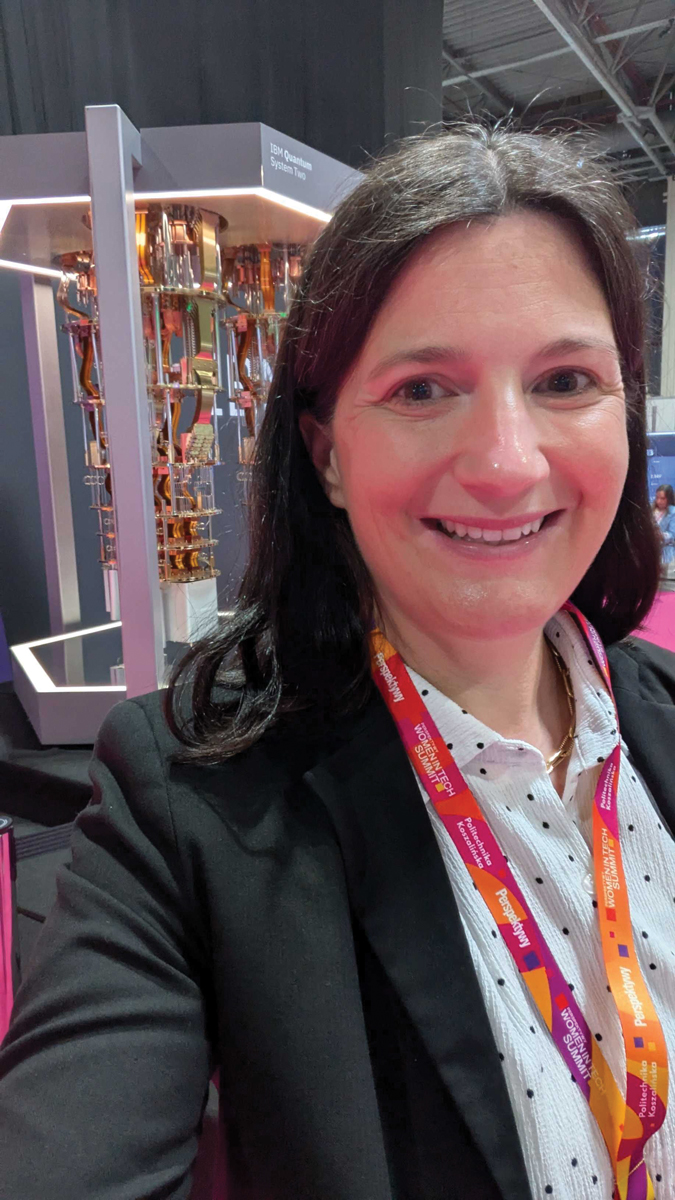Q&A: Kathrin Spendier manages the XPRIZE quantum computing competition
DOI: 10.1063/pt.yjkf.ngoz
When Kathrin Spendier gave up tenure, she switched not only from academia to the private sector but also from biophysics to quantum computing.
Pivoting—and risk-taking—was nothing new for Spendier: She grew up in Austria dreaming of becoming a professional skier, then switched to a career in physics. At the end of high school, she ranked in the top 100 worldwide for slalom skiing but still didn’t make the cut for the Austrian team. She was recruited to ski for the University of New Mexico. In 2004, she helped the school win a national ski championship. She later earned her bachelor’s and PhD degrees in physics there.

Kathrin Spendier (Photo courtesy of Kathrin Spendier.)

After about a decade as a professor at the Colorado Springs campus of the University of Colorado, she left academia in 2022 and joined the quantum software and computing startup Quantinuum as a quantum evangelist. She oversaw the company’s sponsorship and operations of hackathons, explained quantum computing at universities around the country, and worked on building the pipeline for the quantum workforce. It was, she says, “like teaching on steroids.”
In 2024, she moved to XPRIZE, which runs competitions that encourage innovation to solve societal problems. Since the foundation got its start in 1994, more than 35 000 people from 173 countries have participated in 30 competitions—offering a cumulative purse topping $519 million—in topics such as tackling water scarcity and enabling private suborbital spaceflight.
Spendier oversees the XPRIZE’s competition in quantum applications. Teams compete to develop quantum computer algorithms that can outperform the best classical methods to address problems in climate modeling, drug safety, fusion reactor design, and other areas with societal impact. Currently, 224 teams are participating. Prize money totaling $5 million will be distributed in stages, with up to three winners to be selected in early 2027.
PT: Describe your education path.
SPENDIER: I wanted to do math, but a physics professor at New Mexico who knew I was a skier steered me to physics. He said, “Don’t you know that physics and skiing go together?” and told me about friction and snow. Still, athletes have a bad reputation—it took some work to convince the faculty in physics that I was not just there for the ride.
During my junior year, I started building optical microscopes in Jim Thomas’s lab. Then I went to grad school.
My first year, I worked at Brookhaven National Lab, in particle physics. But it was too big. I missed tabletop experiments. I went back to Jim. For my PhD, I built a total internal reflection microscope and studied receptor motion. I also did some reaction–diffusion theory.
PT: Why did you leave academia?
SPENDIER: It was a long process to decide to look for something else. At Colorado Springs, I started a biophysics program and taught the whole physics curriculum, which was great. But I was doing too much: I wasn’t teaching well, because everything was last minute. In research, I didn’t have time to guide the students. And I was always trying to find funding. Once you have tenure, you are automatically asked to do more administrative tasks. And I was not good at saying no.
And the whole time, I felt that I didn’t have enough time for my kids. Then one day, I had my computer in the playroom, and my littlest one said, “Mommy, you don’t have time for me.” It wasn’t the first time, but it finally clicked. I was not joyful anymore. I was grumpy all the time.
PT: Was it scary to give up tenure?
SPENDIER: Yes. At first, I was going to take a leave from Colorado Springs. But they told me they couldn’t hire someone if I did that, and I knew they were in dire need of teachers, so I gave up my tenured position. I had an active research grant from NIH at the time, on superresolution microscopy. I retained an affiliation for a while to help a student finish their PhD.
PT: How did you move into the quantum computing arena?
SPENDIER: Biophysics was an elective course, and it was on the cusp of not being offered. I told the graduate students, “Let’s do a few weeks of quantum computing in the biophysics class.” That got enough of them to sign up for the class to go ahead. And in the class, everyone was excited. They asked so many questions. I stayed up late reading up on quantum computing.
When I started looking for jobs, I had the confidence to look into quantum computing.
PT: How did you make the move?
SPENDIER: I worked a lot with LinkedIn, just applying for jobs, mostly in technical sales in health science and microscopy, and seeing what stuck. I also had interviews for data-science positions, but I typically didn’t get far because I didn’t have much coding experience.
I realized I would need help. I reached out to a professional resumé writer who helps academics package their skills in 2 pages instead of 15. Academics brag about themselves and their work, but when you look for an industry position, you have to elevate the company.

Kathrin Spendier (third from left) serves on the panel “Applications of Quantum Technologies—Bridging Science, Policy, and Business” at the Women in Tech Summit in Warsaw, Poland, in June. (Photo courtesy of the Perspektywy Women in Tech Summit.)

I ended up with three options. Two were in technical sales, in optics and microscopy. And the third was the job I took: in education outreach for Quantinuum. I thought that was interesting because quantum computing was popping up more and more as a hot topic.
Part of my job was to take algorithms and show students how to compile them and run them on a quantum computer.
PT: How does XPRIZE work, and what is your role?
SPENDIER: XPRIZE is a nonprofit that creates prize competitions to incentivize solutions to humanity’s grand challenges. It’s all about finding where humanity is stuck in terms of technology and then finding ways to accelerate getting unstuck and making lives better. It could be carbon capture, clean water, or personalized medicine.
XPRIZE finds the barriers and defines the competitions: How long should they last? How much money should we put into it? What types of gadgets do the teams have to build? What should the winning team achieve? We also have to find who in the ecosystem might be interested in donating the prize money. That is what XPRIZE has been doing for 30 years.
As the XPRIZE Quantum Applications director, I serve as the thought leader and the public face of the competition. At the beginning of the competition, I recruited teams. With the help of our advisers, I find judges with the right technical backgrounds and then work with them and the advisers to develop the competition guidelines and judging criteria. I document everything—it’s like writing a technical paper.
PT: Do you miss academia?
SPENDIER: I miss my colleagues. And I miss tinkering with equipment. Initially, it was hard not having a lab, and I had to teach myself not to work on weekends. But with what has been happening lately with academia, all the uncertainty they are going through—with federal funding, visas, and attacks on diversity, equity, and inclusion—my former colleagues are worried. I am very sad for them. And I’m glad I am not there.
PT: Do the cuts to federal funding affect you and XPRIZE?
SPENDIER: Not directly, but I believe there will be a trickle-down effect.
The prize money comes after the fact: The teams show that they can do something and then receive additional funding from us. The purse cannot go to anyone in a country sanctioned by the US government. If more countries are sanctioned, we may have teams from a smaller pool of eligible countries. And we have teams from academia. If they have less funding, the teams may be smaller, or there may be fewer teams.
PT: How do you use your physics in your current role?
SPENDIER: Being analytical, problem-solving, seeing patterns and then adjusting what you do according to the patterns is very much needed throughout my work. I have noticed that leaders of companies are very analytical. With a physics degree, you get a problem-solving mindset. You learn how to put things together and make them work. Those skills are very applicable on the business side—more so than you would think.
This article was originally published online on 29 July 2025.
More about the Authors
Toni Feder. tfeder@aip.org





